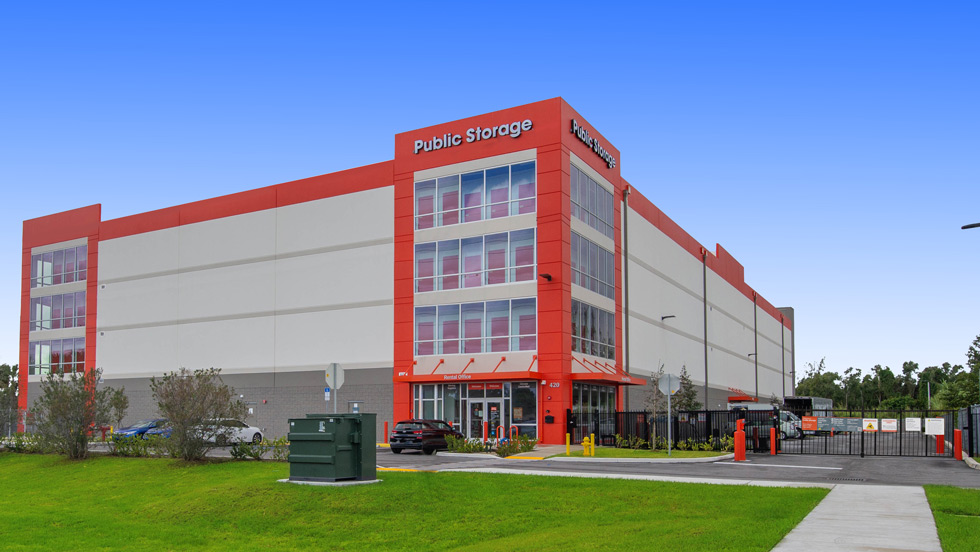The company’s brand with the bright, roll-up orange doors and simple name has become synonymous with the self-storage industry as it marks its 50th year in business.
Fifty years ago, the founders of Glendale, California-based Public Storage (NYSE: PSA) knew they were onto something big when they discovered the then-relatively new self-storage niche. However, they may not have predicted just how massive the business would become.
Today, the company’s brand with the bright, roll-up orange doors and simple name has become synonymous with the self-storage industry as it marks its 50th year in business. It’s widely recognized as the largest self-storage owner/operator in the world and among the largest publicly traded REITs by market capitalization at $52 billion.
Last year was one of Public Storage’s most successful years, reporting unprecedented rental rates and occupancy due to the pandemic-era boom. Self-storage ranked among the top-performing asset classes during the health crisis, as more Americans chose to store their extra belongings as they reevaluated their living conditions, moved, downsized, and decluttered. Storage space rented quickly, buoying storage stocks.
Self-storage remains in high demand by both customers and investors as billions of dollars has flowed into the space. Public Storage has reaped the benefits. In 2021, its revenue was $3.4 billion, a 17% increase over the previous year’s revenue of $2.9 billion.
Despite massive growth, Public Storage started small when B. Wayne Hughes and Kenneth Volk, Jr., each put up $25,000 to launch the business at a time when the concept of self-storage was somewhat novel. The two met in the 1970s when Hughes was an executive vice president and top producer at a real estate investment company, and Volk was ready to sell his development company, Volk-McLain Communities, Inc. Hughes oversaw the sale of the assets.
The two became friends and wanted to partner on some entrepreneurial endeavor. When Volk stumbled upon a small storage facility in Houston, which had a waiting list, their plan was set in motion.
Public Storage’s first facility opened along a busy freeway in El Cajon, California, in 1972. The grand opening was a fiesta-themed celebration complete with a mariachi band. Their first customer was an STP Motor Oil distributor, who desperately needed somewhere to store the oil cans piled up in his driveway.
“We built No. 1 and took it from there,” the late Hughes recounted in a book about Public Storage. By 1974, the company had 20 locations. Their philosophy was to continue developing properties until they stopped filling up. Fifty years later, that still hasn’t happened.
Public Storage became a REIT in 1995 and joined the S&P 500 in 2005. In 2006, it acquired Shurgard Storage Centers, Inc., a leading owner/operator of self-storage facilities. Today, the company boasts more than 2,800 facilities across 40 states in the U.S., totaling approximately 200 million square feet, and 224 facilities in Europe.
Public Storage has roughly 1.8 million customers, 80,000 to 100,000 move-ins a month, and more than 5,000 employees. It continues to grow through aggressive acquisitions and a robust development platform.
‘Classic Story’
Joe Russell, Public Storage president and CEO, describes the REIT’s origins as “a classic entrepreneurial story and a new idea.”
When Hughes and Volk partnered to launch that first facility, Russell says, “this was a product type that had no anchor or visibility to the customer base.” A lot of time and energy went into trying to determine if people would really pay to put stuff into a garage space. “How do you design it? What are the attributes from a location standpoint that make sense? Like any formation of a new entrepreneurial endeavor, there was lots of trial and error,” he adds.
Russell notes that the inherent beauty of the product is its simplicity. “It’s a garage space or a cubic box, and it’s very compelling because time and time again, in and out of economic cycles, and in and out of all kinds of demand and fluctuation, it remains a resilient, extraordinary business,” he explains.
Russell says the founders, followed by the company’s second CEO and current Chairman Ron Havner, took a creative approach that led Public Storage through massive growth, consumer awareness, branding, and determined industry leadership. “It’s just a great story,” Russell notes. “And we’re keeping a very keen eye on that history as a company because many of the things that led to our initial success are still with us today. That includes thinking about fresh perspectives that drive the business and continuing to improve the platform.”
Multiple Generation
Self-storage has evolved from locations on the outskirts of town to climate-controlled, state-of-the-art facilities in high-profile locations near urban centers. They’re bright, modern, landscaped, and amenity-filled.
“Many of the assets we own, we’ve developed over the last 50 years, so we’ve elevated our design and location attributes to what we call a generation five standard,” Russell explains.
Generation one was simple drive-up spaces, where customers entered through a gate, drove up to the unit, and rolled up the door. Facilities were 30,000 to 50,000 square feet, single story with 300 to 400 units.
In generation two, Public Storage started making units bigger and properties more dense. Generation three transitioned to multistory with added amenities like climate control.
Generation four was more multistory facilities with improved customer access, more space sizes, more security, additional elevators, and more climate control.
“Our fifth generation is even more polished and finished and provides more amenities,” says Russell.
The company has properties as large as 250,000 square feet in dense, highly-populated areas. Its tallest building is in the Bronx and was a conversion of a 12-story warehousing and parking building. The company has a redevelopment planned in Los Angeles that will be a couple stories higher.
Depending on the location and demand, the company will build very dense. Some facilities have 4,000 plus-units including one outside of Manhattan that’s a full city block. Public Storage owns prime real estate in markets like Los Angeles, San Francisco, Miami, and New York. The company also continues to develop its more traditional model in smaller, less-dense markets.
Recession Resistant
Self-storage has long been praised as recession resistant with a history of profitability, even during the toughest economic times. Customers have a continual need for storage as they move, downsize, divorce, land a new job, or lose a job. Those constant, relentless qualities attract investors to the space.
Self-storage is fueled by the four “D’s:” divorce, death, dislocation, and disaster, which play out in life, regardless of the economy. Through the pandemic, a fifth ‘D’ emerged, which is decluttering.
“COVID created new demand drivers for self-storage with accelerated usage and adoption of the product,” says BMO Capital Markets analyst Juan Sanabria. “That included people spending more time at home and creating more space for a home office, gym, or classroom.”
The pandemic also drove dislocation. “There was an uptick in housing turnover as people looked to move from the cities to the suburbs,” Sanabria notes. “These factors created strong outside demand for self-storage, resulting in rising occupancy rates, which allowed the operators to pass along larger and more frequent rent increases than in the past.”
Russell notes that these pandemic-related customers are staying in place, recognizing the convenience and cost benefits of self-storage. Today, more than 10% of all U.S. households rent self-storage units, according to the Self-Storage Association.
Additionally, as housing costs soar, people are looking for smaller, more affordable living spaces and need to store extra belongings. Businesses are also key storage tenants. With more companies contemplating permanent remote work, they’re downsizing or eliminating offices, boosting the need to store furniture and files.
“Over the last couple of years, we hit occupancy levels that frankly we had never seen before,” Russell points out. “Certain markets and assets reached 97, 98 and even 99% occupancy levels.”
For Public Storage’s second quarter of 2022, same-store occupancy was 95.8%, down from 97% year over year. Same-store revenues jumped 15.9% over the previous year while same-store net operating income (NOI) increased 17.8%.
Fueling Growth
Self-storage remains a fragmented industry with less than 20% of square footage owned by REITs, and a majority owned by small operators. Public Storage, which owns roughly 10% of the total self-storage square footage in the U.S., continues to expand. Since the beginning of 2019, it invested $7.4 billion in acquisitions, development, and redevelopment, adding 38 million square feet to its portfolio.
The company has been on a recent buying spree, acquiring $5.1 billion in assets in 2021, roughly 30% of the entire industry volume. Its acquisition strategy involves finding attractive deals, rebranding the properties, and using its competitive advantages to enhance operations where previous management struggled.
Deals have included the $1.8 billion purchase of ezStorage’s 4.2 million-square-foot portfolio and the $1.5 billion acquisition of All Storage’s 7.5 million-square-foot portfolio. Russell anticipates up to $1 billion in acquisitions this year.
Industry observers anticipate that these acquisitions will enhance the company’s revenue growth.
“Public Storage has been an aggressive acquirer over the last couple of years and now has a very large pipeline of properties outside its same-store pool that represents about 25% of its revenue,” says Michael Goldsmith, analyst at UBS. “As this collection of properties matures, it should drive revenue growth.”
As for development, the company has an approximately $1 billion pipeline.
“They’re a big developer and really the only public self-storage REIT that develops in any meaningful way on balance sheet,” Sanabria says. “To the extent that there’s any dislocation in the acquisitions market, which has been an important driver of growth for the subsector, they can develop assets on balance sheet accretively and not worry about finding those external opportunities to consolidate the sector. That’s a unique proposition.”
Another avenue of growth is Public Storage’s third-party management business launched in 2018. It has roughly 175 facilities under management, and the platform has the additional benefit of creating a potential acquisition pipeline.
Technology Takes Off
Public Storage invested significantly in technology ahead of the 2020 pandemic, which helped launch the eRental online platform, new mobile app, digital property access systems, and remote property management capability. Public Storage has developed the industry’s first end-to-end digital customer experience, which it offers across the entire portfolio. The company was in the final testing of eRental in March 2020. Six weeks later, it was deployed to its entire then 2,600-facility platform. The contactless environment was essential to improve customer health and safety during the pandemic.
Russell says Public Storage’s customers can complete their lease online in less than 6 minutes compared to about 45 minutes in the traditional meet-with-the-manager, self-storage model. Today, more than half of its customers use the eRental platform. By using the company’s digital channels,
customers can also pay their bill, manage their account, and access their units on their smartphone.
Additionally, Public Storage uses data to better understand customers and maximize revenue growth. By tapping into the data, it can obtain tenant information from rentals, reservations, income, occupancy, mobile use, and location interest. The company leverages that information to predict customer behavior and boost reservations.
“With 1.8 million customers, our data opportunity is massive,” Russell notes.
Looking Ahead
“Like always, the macro-environment can shift and present different challenges and opportunities,” Russell points out. “However, we’re very confident that we’re well-positioned, if in fact, we’re going into some kind of economic recession.”
From an inflationary standpoint, Russell notes that Public Storage is a month-to-month lease business, which is an “unusual and compelling opportunity.”
“Self-storage has historically been seen as a defensive sector,” notes Goldsmith. “It’s able to reprice regularly given all the leases are month to month, and they’re able to pass along inflation better than many sectors.”
Russell also points to continuing strong consumer demand and moderate levels of new, competitive product. “We’re well-positioned not only to weather anything that could come our way but continue to allocate capital and find good opportunities,” he adds.
Industry observers expect a continued, solid performance. “Public Storage has a very defensive balance sheet, which positions the company well, given some dislocation in the credit markets, and in the event of a potential recession, if we’re not already in one,” Sanabria notes. Additionally, he says they’re able to leverage their scale to drive down costs, given their strong purchasing power.
Russell praises the company’s founders for their persistence and foresight and lauds employees who strive to provide an outstanding customer experience.
“We all have a lot of passion for the business, the company, the history, the brand. We bleed orange,” Russell says. “It’s a great business, and the company is in great shape. We’re really excited about our next 50 years.”




